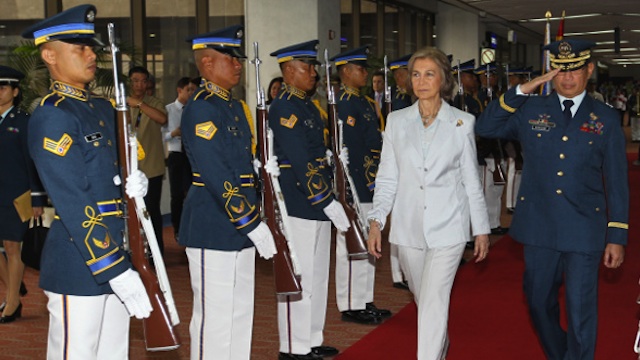SUMMARY
This is AI generated summarization, which may have errors. For context, always refer to the full article.

MANILA, Philippines – Queen Sofia of Spain wrapped up on Friday, July 6 her fourth official visit to the Philippines, aimed at touring Spanish development aid projects and promoting the return of the Spanish language to the public education curriculum.
Her Majesty also met with President Benigno Aquino III, who hosted a dinner for the Queen on Tuesday, July 3 in Malacañang Palace.
In his toast, Aquino proposed writing a “new history” in the relationship between the Philippines and Spain, which colonized the country for over 300 years.
“Today, a new history is being made: of a partnership between two nations with shared democratic ideals; of friendship based, not on nostalgia, but a principled commitment to the positive strength that can be derived from divergent histories, but with a shared, and affectionate, cultural affinity.”
The Queen saluted Aquino’s statement and said Spain views the Philippines “not only as a sister country with whom we share many historical, social and cultural links because of our common past, but also as a key partner in Asia to boost development, to which we are fully committed.”
ODA projects in Manila, Bicol and Mindanao
Queen Sofia spent most of her busy schedule visiting Official Development Assistance (ODA) projects funded by the Spanish government’s development aid agency AECID in Manila, Bicol and Mindanao.
In Manila, Her Majesty toured the Escuela Taller, which helps former street children work on the restoration of historical buildings in Intramuros, the former Spanish citadel in old Manila.
She also made stops at the National Library, the National Museum and the University of Santo Tomas, the oldest institution of higher learning in Asia.
Outside of the capital, the Spanish Queen also traveled on Wednesday, July 4 to Legaspi City in Albay province, where she inspected the Calamig school and evacuation center, a pioneer project that allows for classes to continue even if the event of a natural disaster, and the Academy of Climate Change inaugurated in November by President Aquino.
The next day, Queen Sofia became one of the highest ranking officials ever to visit Zamboanga City, a former Spanish port city where the locals speak Chabacano, a language reminiscent of old Castilian Spanish.

Protected by a police and military security detail set up by Mayor Celso Lobregat, Her Majesty toured several projects for street children and affordable housing established by Spanish NGO Manos Unidas, led by Fr Angel Calvo, a Spanish Catholic priest who has lived in Zamboanga for 44 years.
Spanish in PH schools
Queen Sofia also used her visit to promote the return of the Spanish language to the public education system, as agreed between both governments under the MOU signed in 2010.
Currently over 5,000 students in 66 public high schools across the country study Spanish, taught by teachers trained themselves by professors from Instituto Cervantes and the Education Ministry of Spain.
The Queen herself said she wishes more Filipino students will learn Spanish.
She congratulated the Department of Education for “successfully making reality the re-introduction of Spanish language in the public educational system, not only because it is part of the cultural heritage of the Philippines but also because it opens up opportunities to secure the well-being of future generations of Filipinos in a globalized world.”
“Since the time of the Galleon of Manila, the Spanish language arrived in the PHL as a promising tool for work and development for the Filipino people,” Queen Sofia said in her toast to Aquino.

The government would like to extend the program so Spanish is offered in all public schools, but Malacañang spokesman Edwin Lacierda warns it cannot be done for now due to lack of teachers.
“It is taught in selected public high schools. We have limitations right now. We don’t have adequate teachers. At the moment we cannot make the teaching of Spanish mandatory,” Lacierda said on Wednesday, July 4.
The presidential spokesman added that Spanish is part of our “cultural heritage” and that it is always an advantage to learn a foreign language, so he is looking forward to having more teachers in the future.
Opportunity for investment
Although it was not the purpose of her trip, Queen Sofia’s visit is expected to boost investments by Spanish companies in the Philippines, even if the Spanish economy is in dire straits now.
Her Majesty promised her hosts that she will tell businessman back home that they should consider investing in the Philippines as the ideal gateway to enter Asian markets.
She also suggested to look into infrastructure projects under President Aquino’s Public-Private Partnership (PPP) program.
A Spanish firm, Genitsa, was the first foreign company to bag a PPP contract — the P2-B Daang Hari-South Luzon extension project — in partnership with Ayala Corp.
Spain was the Philippines’ 28th largest trading partner in 2011, with total bilateral trade amounting to $329.6 million, according to the Department of Foreign Affairs. – Rappler.com
Add a comment
How does this make you feel?
There are no comments yet. Add your comment to start the conversation.